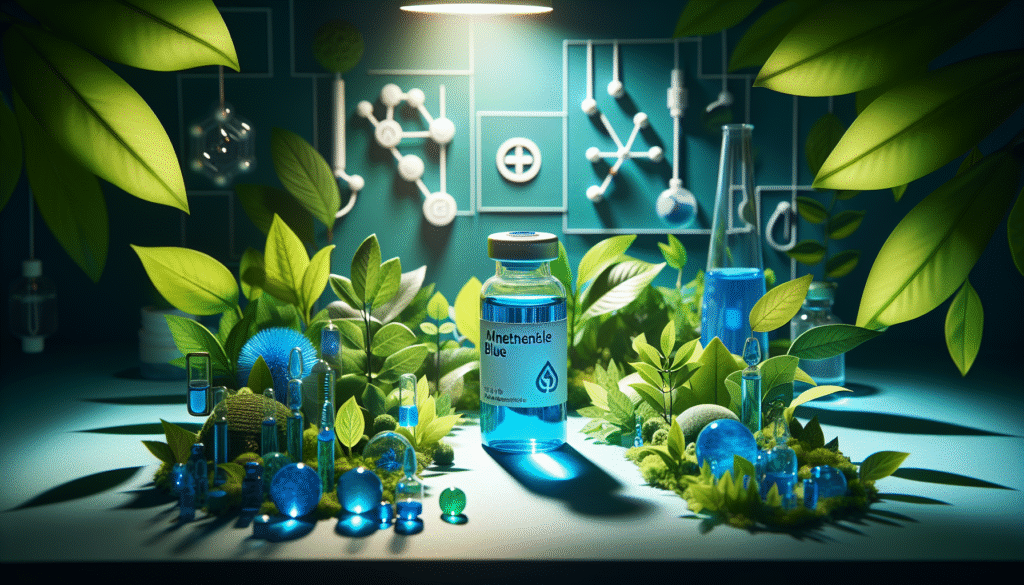
What if a single compound could enhance your health while also being environmentally friendly? This notion has sparked considerable interest in Methylene Blue as a potential sustainable choice for health. Understanding its applications, benefits, limitations, and environmental implications is crucial for anyone pursuing health solutions that are both effective and responsible.

Understanding Methylene Blue
Methylene Blue, a synthetic dye initially introduced in the 19th century, has garnered attention for its diverse applications in both medical and environmental fields. Structurally, it belongs to the phenothiazine class of compounds, characterized by its deep blue color. This compound has been utilized in a variety of medical settings, including as a dye and a medication, but its role in the realm of health has been less frequently discussed.
Historical Context
Originally developed as a textile dye, Methylene Blue quickly found use in medicine. Its first notable application was as a treatment for malaria. Since then, it has been employed for various purposes, including treatment for methemoglobinemia, as an antiseptic, and even for cognitive enhancement in certain experimental studies. Understanding this historical context is crucial because it illustrates the compound’s evolving role in health and medicine.
Chemical Composition
Methylene Blue is composed of carbon, hydrogen, nitrogen, and sulfur. Its molecular formula (C16H18ClN3S) reflects a complex structure that allows it to perform a multitude of functions. The chemical properties of Methylene Blue enable it to act as an electron donor and acceptor, making it a valuable tool in redox reactions, which are fundamental in biological processes.
Health Benefits of Methylene Blue
The health benefits of Methylene Blue cover a spectrum of applications, ranging from behavioral and cognitive improvements to therapeutic roles. Understanding these benefits in detail can help you determine whether this compound is a worthy addition to your health regimen.
Antioxidant Properties
Methylene Blue exhibits antioxidant properties, neutralizing free radicals that can harm your body at the cellular level. This action is critical in reducing oxidative stress, which is linked to numerous health issues, including cardiovascular diseases, diabetes, and neurodegenerative disorders.
Cognitive Enhancement
Some studies have suggested that Methylene Blue may enhance cognitive function, particularly in the context of age-related cognitive decline. By potentially improving mitochondrial function and increasing ATP production, Methylene Blue may support better brain health. Although more research is needed to cement these findings, the implications are promising for those interested in neuroprotection.
Antimicrobial Effects
Methylene Blue has demonstrated antimicrobial properties, effective against various bacteria and fungi. Its use in treating infections is a positive aspect worth exploring, particularly in an age where antibiotic resistance presents a significant challenge. This compound offers an alternative, and its implications for developing new antimicrobial therapies are worth noting.
Methemoglobinemia Treatment
One of the most established medicinal uses of Methylene Blue is in the treatment of methemoglobinemia, a condition where hemoglobin is unable to effectively release oxygen to tissues. Methylene Blue acts as a reducing agent, converting methemoglobin back to its functional form, which is critical for oxygen transport in the blood. This application showcases Methylene Blue’s immediate therapeutic benefits, potentially saving lives in acute situations.
Environmental Considerations
While the health benefits of Methylene Blue are noteworthy, it is equally important to consider its environmental impact. Sustainable health choices should equally prioritize ecological health alongside individual well-being.
Synthesis and Production
The production of Methylene Blue involves synthetic processes that can have environmental consequences. Understanding how Methylene Blue is manufactured helps illuminate the ecological footprint associated with its use. Historically, the synthesis has been criticized for involving toxic chemicals and producing harmful byproducts. However, advancements in green chemistry are beginning to address these concerns, offering more sustainable manufacturing alternatives.
Biodegradability
In evaluating Methylene Blue’s sustainability, it is essential to consider its biodegradability. Traditional assessments indicate that Methylene Blue is not easily biodegradable and can pose risks to aquatic ecosystems when released into water bodies. This characteristic raises concerns about pollution and the compound’s long-term environmental impact. Efforts to mitigate these effects involve finding ways to properly dispose of Methylene Blue and utilize eco-friendly alternatives in medical and industrial applications.
Ecotoxicity
Research shows that Methylene Blue can have toxic effects on aquatic organisms. The implications of this toxicity are significant in defining sustainable practices associated with its use. Responsible sourcing and careful disposal methods can mitigate these risks, and ongoing studies in ecotoxicology will assist in creating safe guidelines for its application.
Risks and Limitations
Understanding the potential risks and limitations of Methylene Blue is vital for informed decision-making. While the compound has useful properties, it is essential to approach its use with caution and awareness.
Dosage and Side Effects
Excessive doses of Methylene Blue can lead to adverse side effects, including headache, dizziness, gastrointestinal disturbances, and allergic reactions. For individuals considering its use for cognitive or health benefits, it is imperative to adhere to guidelines regarding dosage to minimize risks. Consulting healthcare providers before starting any new treatment is a prudent strategy.
Drug Interactions
Methylene Blue may interact with various medications, particularly those affecting serotonin levels. These interactions could lead to serotonin syndrome, a potentially severe condition resulting from elevated serotonin levels. Individuals using antidepressants or other serotonin-affecting drugs should exercise caution and consult with their healthcare providers before using Methylene Blue.
Lack of Consensus in Research
The body of research on Methylene Blue has produced mixed results, particularly regarding cognitive enhancement and therapeutic benefits. While some studies report positive outcomes, others indicate little to no meaningful effects. The lack of consensus complicates the decision-making process for individuals considering Methylene Blue as a health option.

Sustainable Health Choices
For those weighing the potential benefits of Methylene Blue against its environmental implications, understanding alternative sustainable health choices is crucial. Making informed decisions about healthcare options is essential for individual health and the planet’s ecological well-being.
Natural Alternatives
You may wish to explore natural alternatives that offer similar health benefits without the environmental impact associated with synthetic compounds. Substances like curcumin, resveratrol, and green tea extract have gained recognition for their antioxidant and cognitive-enhancing properties and may provide safer, eco-friendly routes to health improvement.
Holistic Practices
Incorporating holistic health practices can also enhance your well-being. Mindfulness techniques, dietary modifications, and regular physical activity contribute to better health outcomes and can coexist with sustainable practices. Prioritizing these approaches often reduces reliance on synthetic drugs and enhances the body’s natural resilience.
Conclusion
Evaluating whether Methylene Blue is a sustainable choice for health demands consideration of its numerous aspects—its health benefits, environmental consequences, and associated risks. This complex interplay of factors is essential in forming a holistic approach to health and sustainability.
If you are considering Methylene Blue as part of your health regimen, weigh its benefits against potential drawbacks, consult credible medical sources, and stay informed about ongoing research. Striving for a balance between personal health and ecological responsibility is not merely a choice; it is a commitment to a sustainable future for yourself and the planet.